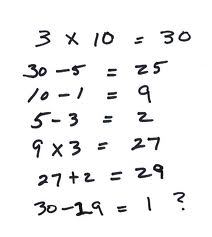Tom, Dick and Harry on the way to a conference decided to stop along the way and get a hotel room. It was late at night, but they saw in the distance ahead a hotel with a neon sign that said “Vacancy.”
By Bill Rusteberg
The three asked to rent three rooms, but were told only one was available. “How much is it?” asked Harry. “It’s $30” replied the clerk. So each forked over $10, received the key and went to their room to retire for the night.
But the clerk soon realized that he overcharged the three. Instead of $30, the actual room rate was $25. So he gave his assistant $5 and said “I’ve overcharged for room 34 – return this refund please.”
On the way to room 34 the assistant thought “I’ll give each of the three men $1 as a refund, and keep the remaining $2 as my tip!”
 The men were delighted to receive their refund of $1 each. So each originally spent $10, but received $1 back for a net cost of $9 each. That means the three spent in total $27 for the room. And of course the bell hop kept $2 as his “tip”.
The men were delighted to receive their refund of $1 each. So each originally spent $10, but received $1 back for a net cost of $9 each. That means the three spent in total $27 for the room. And of course the bell hop kept $2 as his “tip”.
The hotel received a net $29, the bell hop kept $2. Where the heck is the missing dollar?
Health insurance renewals can represent Fuzzy Math too. There can be missing dollars at every turn. For example, a TPA presents a renewal increase of 4% when it is really much more than that. A 25% increase in stop loss premium presented as an overall + 4% “renewal” is a lot easier to sell plus it’s a great way to increase commissions.
Tracking the money trail though health plans is not that hard to do. We once were tasked with reviewing the finances of a 2,500 life self-funded Texas school district. The broker was paid $4 pepm, or about $120,000 per year. But after our review we found the district employed two brokers, one they never heard of or met, and together they were sharing $614,000 per year. The difference between $614,000 and $120,000 was hidden in the claim side of the ledger.
If plan sponsors knew the truth they would be in a position to do something about it. You can’t fix what you don’t see.

